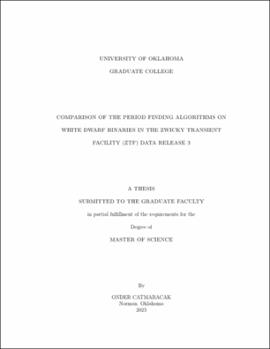| dc.description.abstract | Irregular time series arise in most ground-based astronomical surveys due to atmospheric effects, missing observations, and instrumental issues that create erratic time intervals among data points and reduce data quality. Determining the exact period of a system can therefore be a problem. Building a correct mathematical formulation is required to analyze the unevenly-sampled data and reveal the hidden period information. Parametric techniques assume that the observable data can be represented as a linear combination of trigonometric functions of time. The non-parametric methods, on the other hand, are not affected by the assumptions about the shape of the underlying signal, which helps identify non-sinusoidal behavior.
In this thesis, we mainly consider two notable methods. The Lomb-Scargle periodogram Lomb(1976), and Scargle(1982), developed from the Least-Squares Spectral Analysis Vanicek(1969), is a known parametric algorithm for analyzing sampled time series for periodic signals irregularly. Conditional Entropy Graham(2013a), conversely, is an example of non-parametric approaches originating from the Shannon entropy Cincotta(1995), which uses the information theory and phase-folds the data at each trial frequency and estimates the conditional entropy $H(m|\phi)$ of the data, where m is the magnitude, and $\phi$ is the phase of the signal. According to information theory, the period with the least entropy corresponds to the correct frequency of a stationary signal.
In this thesis, we compare these two methods and identify the approach that provides a better representation for the period of White Dwarf binaries we selected from Zwicky Transient Facility Data Release 3 Masci(2019) Bellm(2018). Lomb-Scargle Periodogram predicted periods of 7 sources and failed to find the correct periods of 8 sources from Burdge(2020). Additionally, out of 34 WD binaries from ZTF DR3, Lomb-Scargle found 33 of them correctly. Conditional Entropy periodogram, on the other hand, accurately predicted periods of all objects. We conclude that Conditional Entropy proves to be more powerful than the traditional methods for detecting periodicities in time series data. | en_US |
